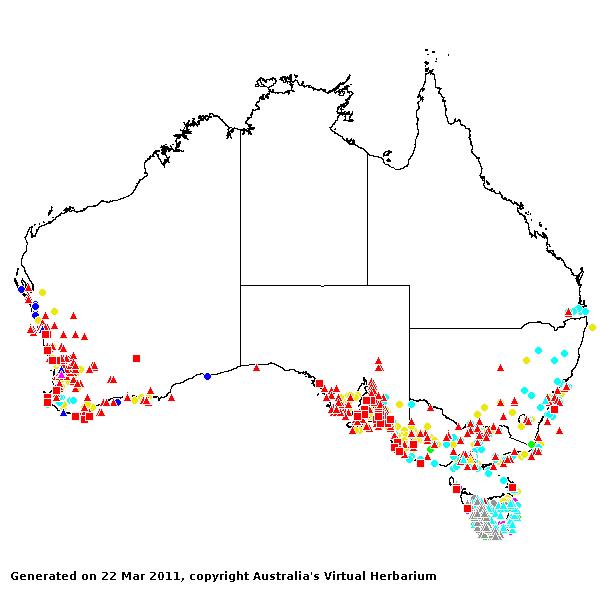Ehrharta* Kongl. Vetensk. Acad. Handl. 40: 216.Tab.8 (1779).
Derivation:. Named for Friedrich Ehrhart. a Swiss apothecary and botanist of the eighteenth century.
Taxonomic revisions, nomenclatural references:. L.P.M.Willemse, Blumea 28: 181–194 (1982).
Key references (keys and floras):. G.Bentham, Flora Australiensis 7: 550–551 (1878); C.A.Gardner, Flora of Western Australia 1 (Gramineae 16–21 (1952); J.W.Vickery, Flora of New South Wales, Gramineae 19: 293–297 (1975); J.C.Tothill and J.B.Hacker, Grasses of Southern Queensland 212–213 (1983); J.P.Jessop, Flora of South Australia 4: 1836–1837 (1986); B.K.Simon, Key to Australian Grasses 107–108 (1993); S.W.L.Jacobs and S.M.Hastings, Flora of New South Wales 4: 652–654 (1993); N.G.Walsh, Flora Victoria 2: 367–369 (1994); D.I.Morris, Student's Flora of Tasmania 4B: 177–184 (1994) (incl. Microlaena and Tetrrahena); E.Edgar and H.E.Connor, Flora of New Zealand 5: 40–44 (2000); D.Sharp and B.K.Simon, AusGrass (2002); J.P.Jessop, Grasses of South Australia 54–58 (2006);S.W.L.Jacobs, R.D.B.Whalley & D.J.B.Wheeler, Grasses of New South Wales, 4th Ed, 223–234 (2008); A.Wilson (ed.), Flora of Australia 44A: Poaceae 2: 370–375 (2009)
W.D.Clayton & S.A.Renvoize, Genera Graminum (1986), genus (89).
Naturalised. 27 species, from southern and tropical Africa and Mascarene Islands. 6 species in Australia, WA, SA, NSW, Vic, and Tas. Also New Zealand.
Habit. Annual or perennial, rhizomatous or stoloniferous or tufted or decumbent. Culms woody and persistent, or herbaceous. Leaf blades broad or narrow. Ligule an unfringed membrane or a fringed membrane or a fringe of hairs.
Inflorescence. Inflorescence a single raceme or paniculate (then narrow, with slender branches), an open panicle with branches ending in single spikelets, open or contracted (though in two species the mature inflorescence base is enclosed in the uppermost leaf sheath).
Spikelets. Spikelets laterally compressed or subterete, more than 2 flowered (with 3 florets, the 2 proximal ones sterile), with 1 fertile floret, awned, solitary, pedicelled; inconspicuously with naked rachilla extension, or with rachilla terminating in a floret. Fertile spikelets with lower incomplete floret(s), disarticulating above glumes.
Glumes. Glumes unequal or more or less equal, shorter than spikelet to exceeding florets, shorter than adjacent lemmas or long relative to adjacent lemmas, hairless, glabrous or scabrous, pointed or blunt (blunt to obtuse), awnless, keeled or non-keeled, similar (membranous). Lower glume 0.5–1 times length of upper glume, 5 nerved. Upper glume 5 nerved.
Florets. Lower incomplete floret(s) sterile. Lemmas curiously varied in form, often hardened and transversely ridged, each bearing a knob-like appendage (elaiosome?) at its base, awned (abruptly from the back, or the lemma tapering into the awn) or awnless, exceeded by fertile lemmas to exceeding fertile lemmas, less firm than fertile lemmas to similar in texture to fertile lemmas, becoming indurated or becoming indurated and not becoming indurated (the first sterile lemma being sometimes non-indurated). Fertile florets 1. Lemmas decidedly firmer than glumes, usually smooth (and often polished) or striate, becoming indurated, entire at apex, pointed or blunt (truncate), muticous (usually) or mucronate (occasionally), without a germination flap, 5–7 nerved, with nerves non-confluent, rarely sparsely hairy or glabrous, 1 keeled. Palea relatively long (narrow), entire, thinner than lemma, 1 nerved to several nerved or nerveless (rarely). Palea keels wingless. Lodicules 2. Stamens 3 or 4 or 6. Grain small, compressed laterally. Hilum long-linear. Embryo small.
Kranz Anatomy. C3.
2n = 24 and 48, 2 and 4 ploid, commonly adventive.
Habitat. Helophytic (most of the annuals), mesophytic. Diverse habitats, with E. villosa in coastal sand dunes. Shade species (E. erecta), or species of open habitats.
Classification. Ehrhartoideae; Ehrharteae.
Notes. Microlaena, Tetrarrhena and Petriella (N.Z.) are placed in synonymy by Clayton and Renvoize (1986). "There is notable variation in such characters as glume length, lemma awns, palea nerves, and stamen number, but these characters are not sufficietly correlated with one another to justify recognition of segregate genera". Recent cladistic studies (Verboom pers. com.) justifies the recognition of the narrowly circumscribed genera Ehrharta, Microlaena and Tetrarrhena, retained in this key (B.K.Simon). The genus Zotovia (=Petriella), allied to Ehrharta is recognised in the Flora of New Zealand (Edgar and Connor, 2000).
Types Species. E. capensis Thunb.
Biogeographic Element. Clifford & Simon 1981, Simon & Jacobs 1990: Naturalised.


